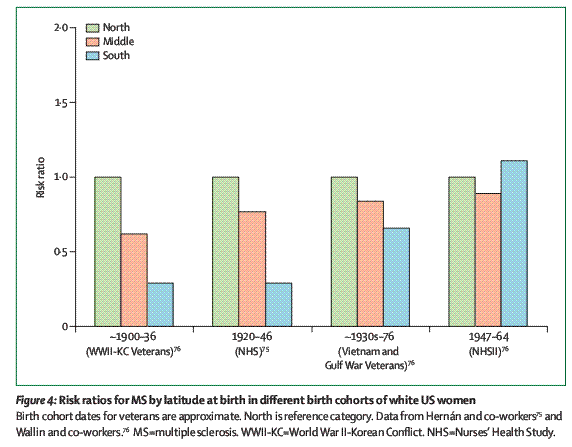Why has the MS latitude gradient disappeared
Why does the north–south gradient of incidence of multiple sclerosis seem to have disappeared on the Northern hemisphere?
Journal of the Neurological Sciences, doi:10.1016/j.jns.2011.09.003
Nils Koch-Henriksen a, b, Per Soelberg Sorensen c, pss@rh.dk
a Department of Neurology, Aarhus University Hospital in Aalborg, Denmark
b The Danish Multiple Sclerosis Registry, Neuroscience Centre, Copenhagen University Hospital Rigshospitalet, Copenhagen, Denmark
c Danish Multiple Sclerosis Center, University of Copenhagen and Department of Neurology, Rigshospitalet, Copenhagen, Denmark
The traditional view, based on numerous early studies and reviews, is that MS is particularly prevalent in temperate zones both on the northern and southern hemisphere. This uneven distribution of MS can be attributed to differences in genes and environment and their interaction. Diagnostic accuracy and case ascertainment are sources of error and have their shares in the geographical and temporal variations, and improvements in diagnostic accuracy and case ascertainment influence incidence- and prevalence rates. In addition the prevalence also depends on survival. With this meta-analysis we have focused on the trend in the incidence and sex ratio of MS through the last five decades, and we have analyzed the latitudinal distribution of MS incidence, based on a recent literature search.
Our findings indicated that the prevalence and incidence rates had increased in almost all areas, but the previously reported latitudinal gradient of incidence of MS in Europe and North America could not be confirmed even when restricting the search to surveys published before 1980 or 1970. Conversely, the latitudinal gradient of prevalence rates seemed to be preserved. This apparent discrepancy can be explained by the circumstance that incidence estimates only depend on complete ascertainment for a relative short recent period of time, whereas reliable prevalence rates presuppose complete ascertainment decades back in time. A contributory explanation for the missing latitudinal gradient for incidence may be changes in environmental factors, levelling out differences in habits of life across Europe and North America, and, not least, that the interpretation of a latitudinal gradient in Europe was based primarily on prevalence studies and reviews.
In addition, we observed in most regions a profound increase in female incidence of MS. The last observation should prompt epidemiological studies focusing on change in female life style.
If registered (free) [tiki-download_file.php?fileId=2003] for PDF which had many graphs
MS association with latitude has virtually been eliminated- Lancet June 2010
Probably due to air conditioning being used in the Southern part of the US

~~Previous MS vs latitude


Possible reasons for women getting more MS recently
A tan is no longer a sign a beauty for women, so not outdoors as much
Increased use of sun-screen when outside - concerned about wrinkles and skin cancer
- Following graph shows a large recent increase in Melanoma, which like MS, is associated with vitamin D deficiency

See also VitaminDWiki
More females have MS – perhaps due to vitamin D deficiency – Feb 2011
Hypothesis – China air conditioning disease is the result of less vitamin D – March 2011
Diabetes rising quickly in areas with recent air conditioning – June 2011
Hypothesis of cause and effect of vitamin D deficiency which had the following chart

Items in both categories MS and Far From Equator are listed here:
{category}
